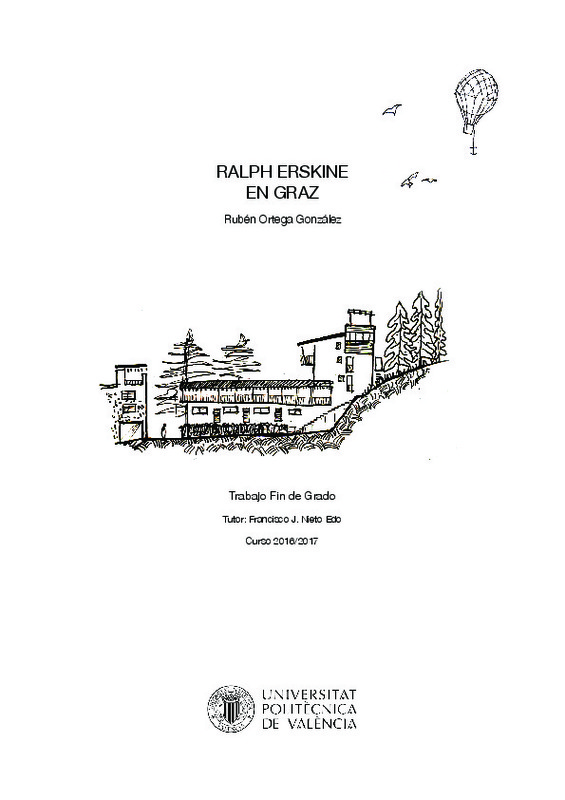JavaScript is disabled for your browser. Some features of this site may not work without it.
Buscar en RiuNet
Listar
Mi cuenta
Estadísticas
Ayuda RiuNet
Admin. UPV
Ralph Erskine en Graz
Mostrar el registro sencillo del ítem
Ficheros en el ítem
| dc.contributor.advisor | Nieto Edo, Francisco José
|
es_ES |
| dc.contributor.author | Ortega González, Rubén
|
es_ES |
| dc.coverage.spatial | east=15.439503999999943; north=47.070714; name=Herrengasse 5, 8010 Graz, Àustria | es_ES |
| dc.date.accessioned | 2018-10-08T13:46:47Z | |
| dc.date.available | 2018-10-08T13:46:47Z | |
| dc.date.created | 2017-09-14 | |
| dc.date.issued | 2018-10-08 | es_ES |
| dc.identifier.uri | http://hdl.handle.net/10251/109916 | |
| dc.description.abstract | [ES] Aprovechando mi estancia en Graz (Austria) y la existencia de un complejo residencial diseñado por Ralph Erskine y Hubert Riess se decide redactar el Trabajo Final de Grado sobre dicho barrio. Los edificios son aquellos elementos que un arquitecto diseña pero el espacio que queda entre ellos es si cabe de mayor importancia, donde la vida tiene lugar. En este complejo de vivienda del año 1988 los edificios y la naturaleza se funden. Esto permite un análisis profundo abordando el edificio como volumen que ocupa la naturaleza: la naturaleza como cosa que cose los edificios, los vecinos como personas que habitan el lugar, los espacios comunes como creadores de vida, el coche como juguete del habitante y los materiales como el contacto entre la artificial y lo natural. Se podría decir que la unión de estos puntos forma la ciudad. Wienerberger-Gründe es un buen ejemplo para estudiar la vivienda unifamiliar en la ciudad y la vida en ella. | es_ES |
| dc.description.abstract | [EN] Taking advantage of my residence in Graz (Austria) and the existence of a dwelling complex designed by Ralph Erskine and Hubert Riess is decided to write the final grade work about this neighborhood. The buildings are those elements which architects design but the space between those buildings is as important as the buildings themselves, where the life take place. In this urbanization of the 1988 the buildings and the nature are fused. Therefore this allows a deep analysis approaching the buildings as the volume which is in the nature: the nature as the thing that sews the buildings, the neighbors as the persons who live in the place, the common spaces like the creators of life, the car as a toy of the inhabitant and the materials as the contact between the artificial and the nature. It is possible to say that join of these elements creates the city. Wienerberger-Gründe is a nice example to study the single family home in the city and the life there. | es_ES |
| dc.format.extent | 113 | es_ES |
| dc.language | Español | es_ES |
| dc.publisher | Universitat Politècnica de València | es_ES |
| dc.rights | Reserva de todos los derechos | es_ES |
| dc.subject | Ralph Erskine | es_ES |
| dc.subject | Hubert Riess | es_ES |
| dc.subject | Graz (Austria) | es_ES |
| dc.subject | Wienerberger Gründe | es_ES |
| dc.subject | Housing | es_ES |
| dc.subject | Garden city | es_ES |
| dc.subject | Viviendas | es_ES |
| dc.subject | Ciudad jardín | es_ES |
| dc.subject.classification | PROYECTOS ARQUITECTONICOS | es_ES |
| dc.subject.other | Grado en Fundamentos de la Arquitectura-Grau en Fonaments de l'Arquitectura | es_ES |
| dc.title | Ralph Erskine en Graz | es_ES |
| dc.type | Proyecto/Trabajo fin de carrera/grado | es_ES |
| dc.rights.accessRights | Abierto | es_ES |
| dc.description.bibliographicCitation | Ortega González, R. (2017). Ralph Erskine en Graz. http://hdl.handle.net/10251/109916 | es_ES |
| dc.description.accrualMethod | TFGM | es_ES |
| dc.relation.pasarela | TFGM\72504 | es_ES |
Este ítem aparece en la(s) siguiente(s) colección(ones)
-
ETSA - Trabajos académicos [4687]
Escuela Técnica Superior de Arquitectura






